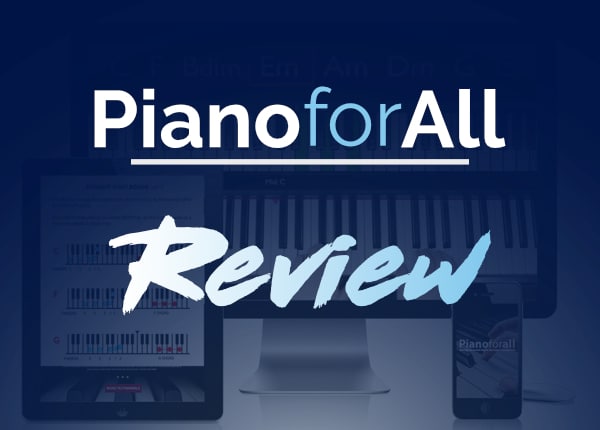As a hobbyist piano player, or maybe I should say more accurately, aspiring piano student, I have tried many of the subscription-based piano learning apps, various books, and other methods. I was looking for a course or method that would help me with my specific goals of learning to play and make music on the piano.
I didn’t want to just memorize the latest pop song or follow along to sheet music. I wanted to learn how to play along with friends in a jam session or accompany someone singing, and even create my own music.
Pianoforall has been the perfect method to help me get closer to those goals and set a solid foundation for learning to play and create music.
Pianoforall is a popular method to learn the piano used by over 300,000 students. It is one of the first digital interactive courses, and I would consider it still one of the best. That is why I am writing this Pianoforall Review.
Rather than starting with you learning simple melodies and nursery rhymes, you start learning chords and rhythms right away so you can start to sound good within days.
No one wants to hear you play Twinkle Twinkle Little Star, but play the rhythm and chord progression to a Beatles song? Then you might get some people’s attention.
Are you not sure if Pianoforall can help you learn piano or even sound halfway decent within a few days?
Keep reading. This article will be an in-depth review of Pianoforall on how this method teaches you and exactly what you will get out of this course. Then you can decide whether or not Pianoforall is the course for you.
Are You Ready To Master The Piano?
Pianoforall lays a FOUNDATION that can be applied in ANY direction and any musical style. When you learned how to read and write you didn’t just learn other people’s sentences – you learned the alphabet so that you could construct your OWN sentences. Pianoforall gives you the tools to play whatever style you want.
What You Need
There are a few things that you will need to make the most out of the PianoForAll method. Most of them are the basic requirements you need to view the course and practice.
I’ll save the most important one for last.
1. A Piano or Keyboard
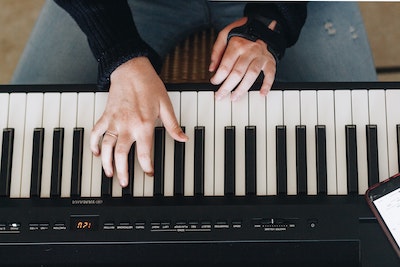
You need some kind of piano or keyboard. If you are just starting out I would recommend getting a 61-key or more preferably 81-key digital piano with weighted keys.
Note: I am using a MIDI keyboard connected to my computer to practice.
2. A digital device to view the ebooks
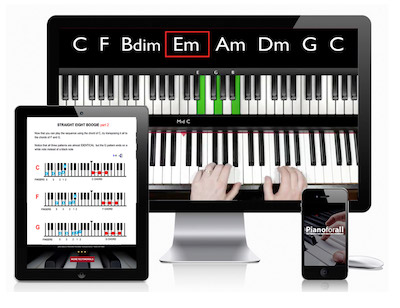
This is a digital product so you will need to have some kind of device to view the course with. The great thing is it will work on pretty much any device. This works on Mac/Windows/iPhone/iPad/Andriod devices so you should have problem with accessibility.
- Mac/iPhone/iPad
You can simply use the Apple “Book” app to read e-books and listen and watch the embedded audio/video clips. I love this method because the “Book” app will sync your location over all your devices.
- Windows/Android
They recommend downloading a program called “Kotobee”, which is an ebook creator and read that allows you to embed media into an ebook.
3. The Most Important Thing: Persistence
What is included in the PianoForall Method
When you purchase the course, you get lifetime access to all the material and any future updates to the curriculum.
10 e-books – You get 10 e-books that are comprehensive in the knowledge that they teach. Each book focuses on a certain style or genre while introducing chords, songs, music theory, and exercises that complement the skills you are learning. The Jazz book is split into 2 sections because it is pretty music theory heavy. I’ll go more in-depth farther down in the article.
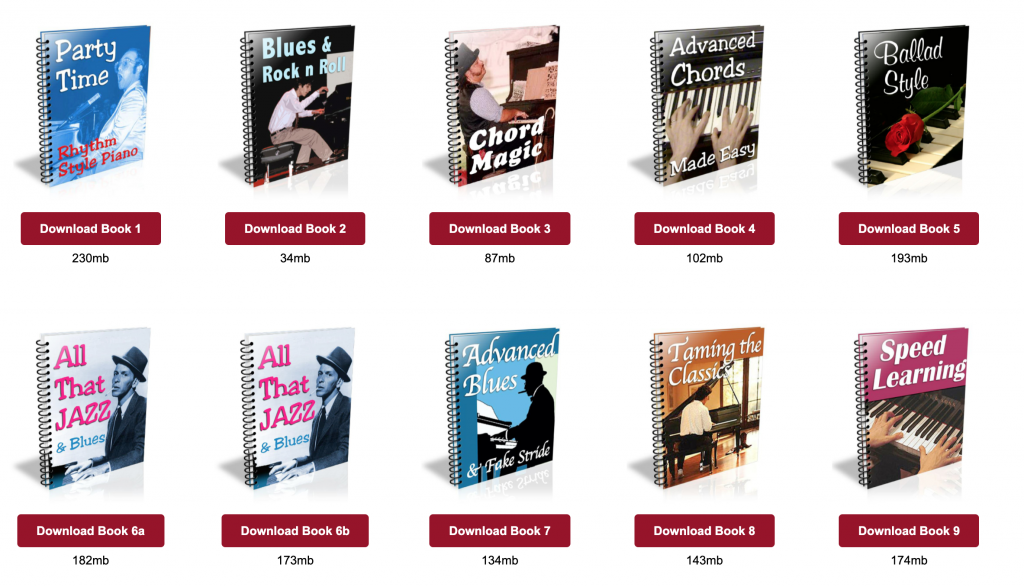
200 video lessons – These are embedded directly into the e-books. These videos further explain the concept within the e-book and provide visual examples.
The videos are of the instructor, Robin Hall, playing the piano from a bird’s eye view with an animated keyboard showing the keys. This makes understanding what notes you should play, fingerings, and how it should sound extremely easy to understand.
Note: I found it very convenient to have the video contained within the e-book. I have gone though a course before that just supplied a standard PDF with a folder of videos and another folder of audio. This was a constant hassle to go back and reference the right video or audio.
500 audio examples of exercises and chord progressions from songs – These are beside each exercise in the book. So you can easily reference how it should sound.
This should be included in every music theory book because of how useful it is!
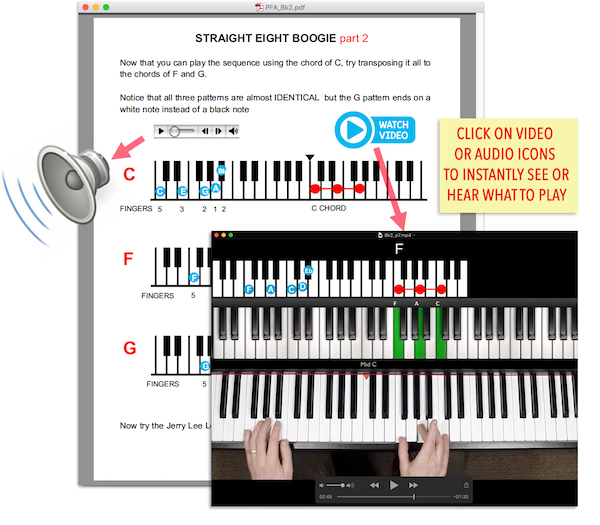
What To Expect From PianoForAll
When you purchase any course, you expect some kind of outcome or achievement.
You may be asking yourself what you should expect of your piano playing after properly completing this course?
Well, I can tell you – You would expect to be a proficient intermediate level piano player with the ability to improvise and play music – not just memorize sheet music.
This course has a strong foundation in learning the chords which is accompanied by a good amount of music theory training and explanation. This was the main point that got me to buy this course. This course would train me to learn music and songs by way of the piano.
Not like other courses that might just teach me how to move my fingers and read music.
Here are some things you will learn:
Improvisation – Almost everyone that picks up an instrument wants to be able to get to the point where they can express themselves through that instrument. This course helps you develop those skills to improvise on the piano. This is mainly in the 6th book in Jazz Piano
Music Theory – Throughout all of the books the instructor, Robin Hall, gives you just enough music theory to understand what is happening or why you are playing those notes, but not so much that you get overloaded. You will learn a lot of chords! This knowledge will transfer to any other instrument that you pick up as well!
Many Styles of Piano – The first book especially focuses on learning lots of rhythms in different styles. This has helped me by making me feel more confident when I am jamming with other people, I am not stuck playing the same old rhythms for everything.
Curriculum – How does Pianoforall Teach Piano?
The Pianoforall course is divided into 9 books (2 parts for jazz). Each of these books introduces you to new concepts or aspects of piano playing that will progressively build off of the previous one.
The idea with Pianoforall is that you should build a solid foundation by using chords, real rhythms and grooves. This way you can build the other skills on top of that and learn to play by ear and sight read as you progress.
Most other programs have you learning to sight-read with minimal theory explanation. This leaves most hopeful piano learners feeling hopeless as they don’t know how to play by ear or how music actually works.
As you can see, Pianoforall lays the foundation by having the first 4 books dedicated to rhythm and chords. The rest of the books build on that foundation by now introducing improvisation, composing melodies, sight-reading, and so many other styles.
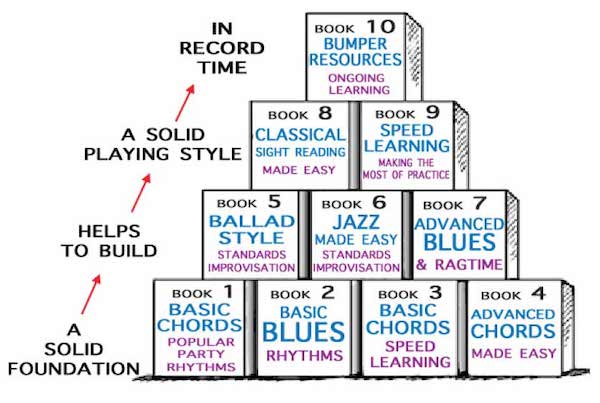
I wanted to show you what the main focus of each book is so you can get a better understanding of how you will learn to play piano with Pianoforall.
Book 1: Party Time – Rhythm Style Piano
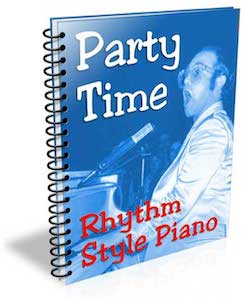
The first book is a primer for the piano and the rest of the course.
The main goal this is book is to get you introduced to 10 very common rhythms played on the piano, but it includes so much more! If it just taught 10 rhythms, there is no way it would have over 100 pages of content.
When you first open this book you will be introduced to the keyboard and given some very basic knowledge of the keyboard. Then you will start right into learning and playing some basic 4 chord progressions.
However, by the end of this first book you will have know most of the Major and minor chords, learn how to make Maj 7 and 7 chords, and learn what slash chords are. Many of the curriculums and methods I have taken wouldn’t introduce that until much later – mainly because they don’t focus on chords.
It teaches many of the chords and rhythms by using them in context with popular songs from past decades – think Beatles & Bob Dylan.
They are presented in the same manner you might find in songbooks that give you the lyrics and chords symbols – similar to this:
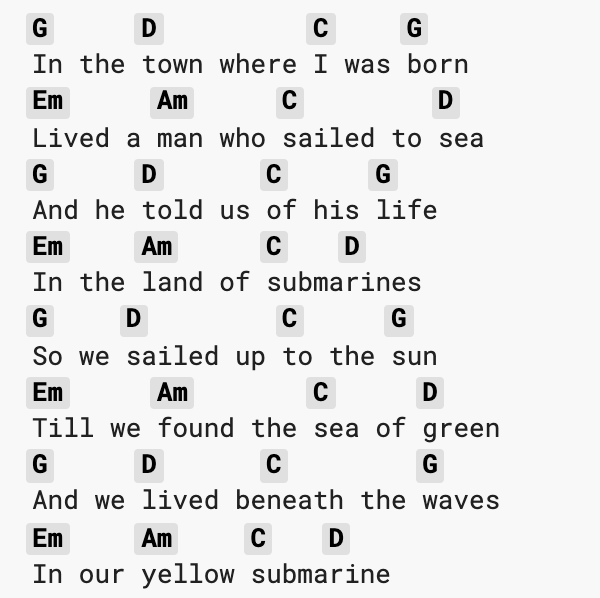
By the end of this book, you will have made a lot of progress and will be able to play chords of rhythms of many popular songs recommended in the book. You will even be able to start looking up and playing songs that you are interested in.
Note: It’s not explicitly stated in the book, but I would really recommend practice playing along with the real song. This will probably be difficult and sound bad at first, but it is extremely beneficial. So push through it!
Book 2: Blues & Rock’n’Roll
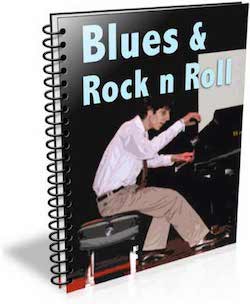
This book is all about the BLUES – as it is aptly named. You will begin by applying blues rhythms to the chords that you have already learned.
You might ask yourself – More rhythms?
Yes, the main principle is to reinforce these rhythms so much in your LEFT HAND so much that you should be able to play them in your sleep. So when you want to get fancy with licks and melodies with your right hand later, you won’t have too much difficulty with timing and coordination. The left hand is very important with the blues.
By the end of this book, you will learn 5 blues rhythms and you will be able to play the 12-bar blues in any key. This book is fairly short compared to the previous book.
Book 3: Chord Magic
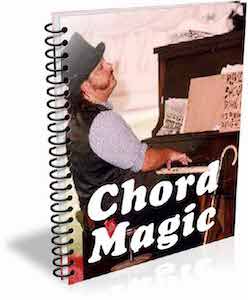
This book is pretty dense as it overs a lot of chord knowledge. You will learn all of the chords in their respective key and all about inversions. These two things will require a lot of memorization and drilling to get proficient at.
Good thing he provides a memory hack to help you along the way!
I found the memory hack pretty useful actually!
You should now know all of the Major and minor chords and be able to reproduce them on the piano very quickly. At this stage the Circle of Fifths is introduced. If you have been involved with music at any point, you have probably heard of this before.
This is introduced to help you understand the relationship between chords as well giving you a good practice regimen.
Book 4: Advanced Chords
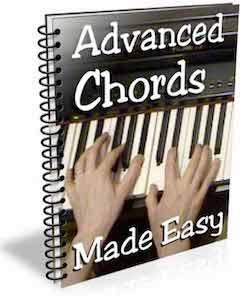
You will learn more about chords and more advanced chord symbols that might encounter when you practice from songbooks by providing a formula to “bluff” these chords or be able to figure out how to play them without having to look it up.
Then he sets up a practical example based on Barry Manilow’s playing and arrangement style. This introduces you to some musical devices and composition techniques. Then you are asked to write your own composition.
I would spend extra time learning some of these concepts outside of this book and analyze how this piece was created. It would be very beneficial to anyone wanting to eventually write their own music.
The final section of this book is all about the style of The Beatles. You are given a list of Beatles songs along with the suggested rhythm and first chord. Take your time learning a few of these songs while attempting to work out the real song in real-time.
Book 5: Ballad Style
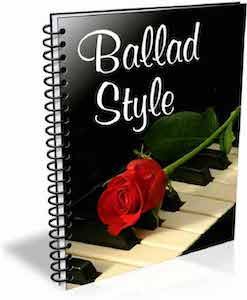
Even though it stays this is about Ballad style, this books is ACTUALLY all about IMPROVISATION. I know this was the part that I was excited about getting to!
You are introduced to a process that will help you begin to develop the skills necessary to improvise. This includes some left-hand chordal patterns, chord progressions, and most importantly the pentaonic scale.
You are now given many exercises to help you learn to improvise. Then you are even actual songs with melody lines to practice the left-hand chordal patterns to learned at the beginning of this book.
The book concludes with some Christmas tunes. I hope you will be ready to bust these out at the next Christmas party!
Book 6: All That Jazz & Blues
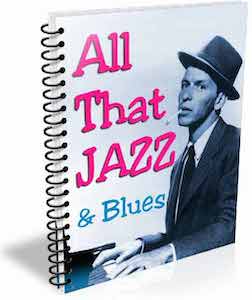
This is another really dense section of the course, and well that is probably to be expected since jazz music can be easily misunderstood. The great thing is that you will have a great foundation in jazz and blues after this book.
You will start off learning more about blues techniques. You can imagine blues being a simplified version of jazz so it will help when making the jump to playing the jazz style.
In the jazz section, the books goes over the now playing chords, especially 7th chords in your left hand while improvising in your right. You will practice a lot of jazz inspired progressions in many different keys. You are especially encouraged to listen to the actual recording and copying the rhythm by ear.
The book concludes with teaching quartal harmony which is said to have a modern sound and a detailed lesson on seventh chords.
Book 7: Advanced Blues & Fake Stride
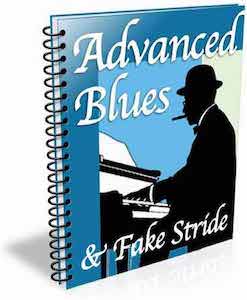
Remember how we said that books 1-4 lay the foundation? Well, book 7 builds off the blues rhythms that you learned with more rhythms and examples of riffs that you can use in your right hand to spice up your laying.
After that, you will start learning about stride piano, which is where your left hand is jumping around from playing bass to a chord in multiple octaves. He teaches you a way to get a similar sound without having to make your left-hand jump around – hence the fake stride, but real sound.
The book ends with one of the biggest classics in ragtime music “The Entertainer”. The instructor goes into a comprehensive tutorial of how to play the song by breaking it down into many parts.
Book 8: Taming The Classics
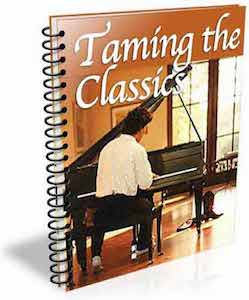
This section is very heavy in the sheet music. So to help you out, the first start of this book has a refresher on music notation.
Note: I wouldn’t expect this to give you a comprehensive view of music notation.
He does give some tips and techniques to sight-reading with the PianoForAll Philosophy. It is important to know the feeling of satisfaction you can feel play these beautiful pieces of music by Beethoven, Bach, and many others.
Personally, I would recommend learning to sight-read because it opens a vast library of music knowledge to you. Think about how much knowledge would be cut off if you couldn’t read.
If you have a goal of playing more music from sheet music, I would recommend focusing time on this section and getting access to other pieces that you can practice with.
Book 9: Speed Learning
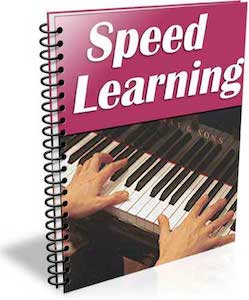
Deliberate practice is the essential skill in mastering an instrument or anything else in life. This book is all about the deliberate practice that will make you better, faster.
This is the “wax on, wax off” of piano practice. (If you old enough to remember The Karate Kid reference). Or you can just think of this as Speed Learning.
Even though this is the last book in the course, you can start it much earlier. I would recommend starting around book 3 or so.
It contains practice workouts and exercises that should accompany what you are learning from the main content. It will help you get a better understanding of scales, key signatures, triads, and seventh chords. This will help in your playing and ability to improvise.
Are You Ready To Master The Piano?
Pianoforall lays a FOUNDATION that can be applied in ANY direction and any musical style. When you learned how to read and write you didn’t just learn other people’s sentences – you learned the alphabet so that you could construct your OWN sentences. Pianoforall gives you the tools to play whatever style you want.
Considerations
Not every course or method can be great at everything which allows them to be great with what they focus on.
Let’s take a look at what PianoForAll focuses on and what it doesn’t focus on.
- Easy to follow and comprehensive – Well Structured. You get a total of 10 ebooks that gradually build up your knowledge of music and skills at the piano.
- VERY Affordable. This is the most affordable piano course on the internet. You don’t need to get stuck paying $20 a month for an app. You get this course for only $39.
- Visual and Auditory Learning. There are over 200 video examples and 500 audio examples included within the ebooks that help speed up your understanding.
- Musicality over Memorization. This course teaches musicality by teaching you how to learn my year, impressive, and create your own melodies.
- Flexibility in Learning. With its self-paced, digital format, PianoForAll is designed to fit into your busy schedule, allowing you to learn at your own pace and from the comfort of your own home.
- Room for Supplementary Learning. While PianoForAll doesn’t place a heavy emphasis on music reading and proper hand position, you can easily supplement your learning with other resources to enhance your skills in these areas.
- PianoForAll emphasizes practical application, giving you the skills you need to play and create music with others. While more detailed practice instructions would be helpful, you’ll still gain valuable skills to use in real-life musical situations.
Will you Learn Piano with PianoforAll?
-
With PianoForAll, you will learn a wide range of skills and techniques to help you become a proficient piano player. Some of the topics covered include:
-
Chords – You’ll learn to play and recognize chords in different keys and how to use them in various progressions.
-
Rhythms – You’ll learn various rhythms and how to apply them to different styles of music, including pop, rock, blues, and jazz.
-
Melodies – You’ll learn how to play melodies by ear and how to improvise and create your own melodies.
-
Music theory – You’ll gain a basic understanding of music theory, including scales, modes, and chord progressions.
-
Playing by ear – You’ll develop your ability to play by ear, which means you’ll be able to listen to a song and play it on the piano without reading sheet music.
-
Sight-reading – Although not the main focus, you will be introduced to sight-reading to a limited extent.
Overall, Pianoforall offers a well-rounded approach to learning the piano that emphasizes creativity, enjoyment, and practical skills.
-
How Much Does PianoForAll Cost?
Pianoforall has a regular price of $79, but for people that have gotten all the way through this article. I have a link to give you a special deal at the discounted price of $39. You can check it out HERE.
That is less than the price of 2 months with many of the piano learning subscription programs. And the great thing is that you can keep this for life.
$20/month for an app? Or a one-time payment of $39 for lifetime access to this course?
Related Questions
Should I buy Pianoforall?
If you want an affordable course that you can use offline and online that will teach you how to musically play the piano, then yes, you would buy Pianoforall.
You get a 60-day mon back guarantee if you are not satisfied with how the course is working for you. That means it is risk-free for you to try it.
There are plenty of examples of testimonials on the Pianoforall Website.
Final Thoughts
I am already a few months into the Pianoforall course, and I can say I have learned a lot more from this course than many of the other popular piano learning apps.
Pianoforall doesn’t just help you become a person that can play the piano. It will help you turn into a musician that can play the piano.
Let me know what you think of Pianoforall in the comments below.
And don’t forget to check out the Pianoforall website by clicking here for your 50% discount.
